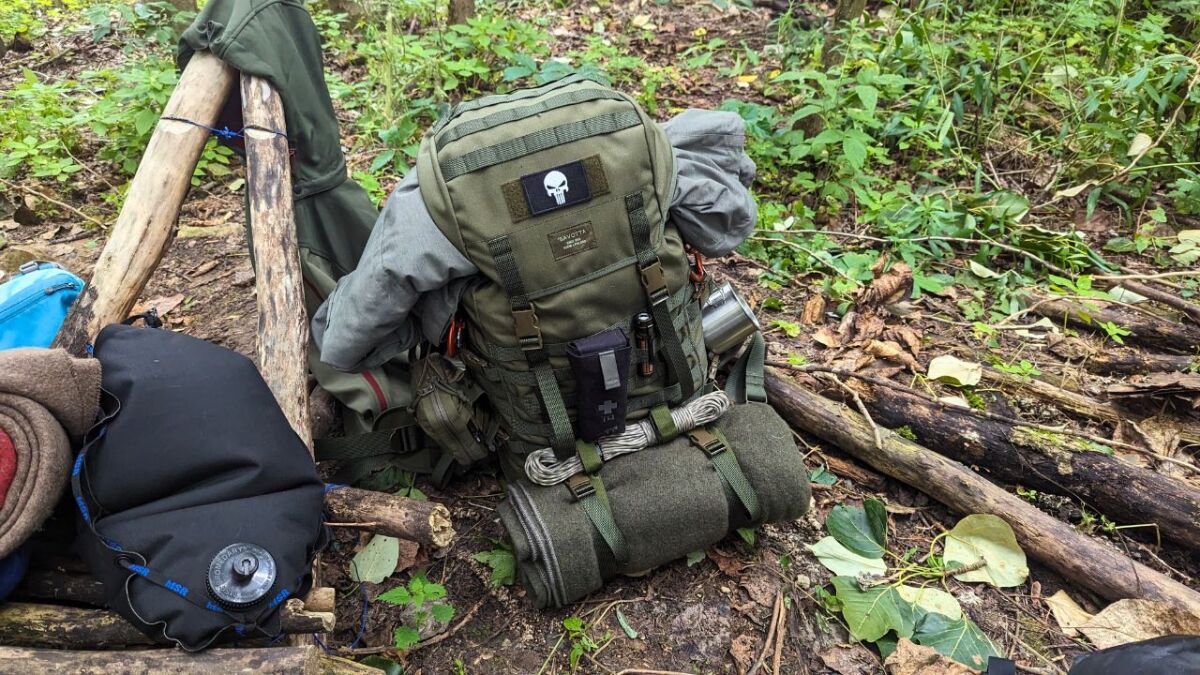
Your Bushcraft Backpack: What is the Optimal Weight? How Much Can a Packed Backpack Weigh?
👉 The key facts from this guide
- You need a bushcraft backpack that is light enough for freedom of movement, but heavy enough for all necessities. A weight of 10-15% of your body weight is ideal.
- The average weight of a bushcraft backpack is 12–18 kilograms (26 - 39 pounds), but the perfect weight depends on many factors.
- Bushcraft backpacks are heavier than day packs or hiking backpacks because you require special tools and equipment.
- The backpack weight changes depending on the duration of the adventure, your skills, climate, and season.
- Choose your equipment wisely: distinguish between necessary and optional items and rely on multifunctional tools.
- Comfort is important: pack heavier items at the bottom and evenly distribute the weight on shoulders and hips, never on the neck.
You are standing in the middle of the forest, surrounded by rustling trees.
The air is fresh, nature is calling.
But wait a moment, do you feel that?
Your backpack is pressing on your shoulders.
How much does this thing actually weigh?
Too heavy? Maybe!
A backpack that is too heavy can quickly turn your nature experience into a frustrating feat of strength.
But don't worry, I know the problem.
I have carried myself through forests and over mountains to uncover the secret of the perfect backpack weight.
The ultimate answer: How much should a packed backpack weigh?
Let's talk straight before we delve deeper into the matter:
How much should a bushcraft backpack weigh?
A packed bushcraft backpack should be light enough to allow you to move freely, but heavy enough to have all the essentials with you. For most trips, a backpack weight of 10-15% of your body weight is just right.
But finding the perfect weight for your bushcraft backpack is an art in itself and depends on many factors.
Now that we have set this baseline, let's dive deep.
I will show you the influences that determine the weight of your backpack and give you tips on how to adjust the weight to your adventure with smart decisions.
Pack it right - Keep an eye on average weight
Before you choose your equipment and start your adventure, let's sort out some facts. I'll take you on an exciting journey through the world of backpack weights.
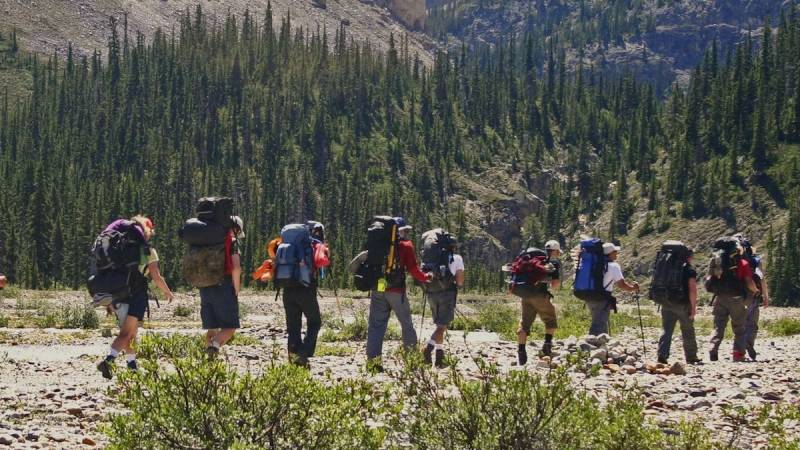
Average is not the same as mean
Imagine meeting with a handful of bushcraft enthusiasts. Everyone has their backpack with them.
The one has wrapped a whole tree trunk, the other only a tarp, pocket knife, and a fire steel.
The average weight here is usually around 12 to 18 kilograms, but that alone doesn't say much.
And that's exactly how I felt 4 years ago.
Do you know how much my 80 liter backpack weighed in February?
23 kg.
The fact is: I have learned from it. Never again. Or maybe just 100 meters.

In comparison: Are Bushcrafters the pack mules?
If you're wondering how these weights compare to other types of backpacks.
Here, a small comparison:
| Backpack Type | Weight Range |
|---|---|
| Day packs (light day trips) | 3–6 kg |
| Weekend Hiker | 8–12 kg |
| Trekking Backpack (multi-day trips) | 12–25 kg |
| All-in-One (long-term campers) | over 20 to 25 kg |
| Expedition Backpacks (long tours) | up to 30 kg or more |
| Escape Backpack / Bug Out Bag | up to 30 kg |
But beware: Don't compare apples to oranges!
Bushcraft or survival and a classic hiking trip play in two different leagues - you need special tools and equipment for your bushcraft excursion, which is not always lightweight.
The fact is: A hiker who goes on a day trip does not need any sleeping gear, such as sleeping bag or sleeping pad.
Factors that influence the weight of a backpack
Are you ready to delve deeper into the world of Bushcrafting?
The perfect backpack weight is not a fixed number - it is a fluid goal that changes depending on the requirements. Pack wisely, not according to a set pattern.
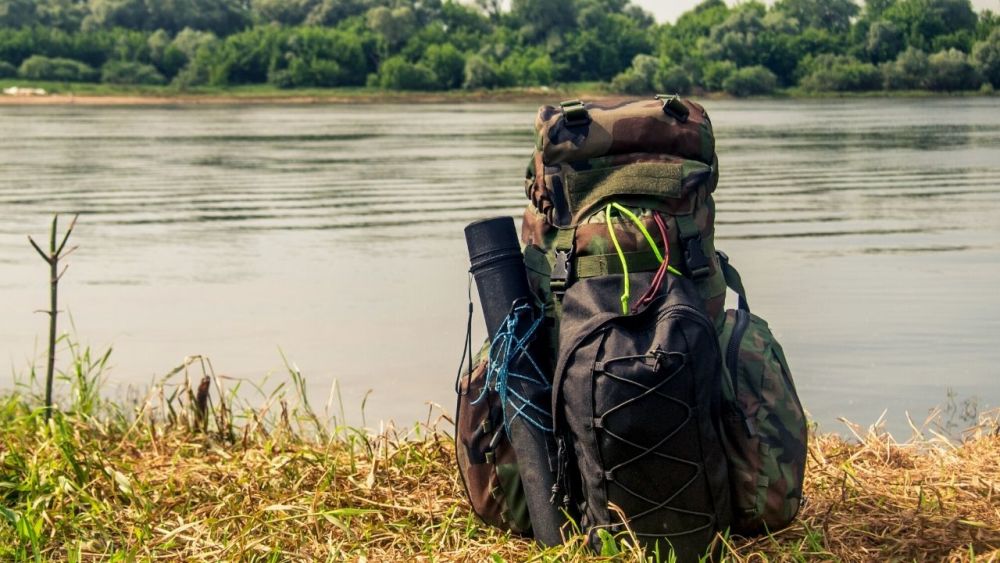
Adventure Duration: Every journey is unique
How long you want to breathe under the stars determines what you pack. Just think about it:
- Short trip (1-2 days): The Minimalism King - Only the essentials come along.
- Weekend trip (2-3 days): The Balanced Act - Enough for comfort, but no excess baggage.
- Long-term tour (5+ days): The Load Bearer - More food, more water, more equipment, more weight.
Personal Skills and Preferences
Your bushcraft skills and personal preferences also have a say. The more you can do, the less you have to carry:
- Experienced Bushcrafters: Experts need less and choose consciously.
- Beginners: Tend to pack more out of insecurity.
"The more you know, the less you carry."
The quote is from Mors Kochanski, one of my favorite bushcraft experts.
Climate and Season: The Weather God Decides
Now let's look up - to the sky. Sunshine or snow flurry?
- Spring & Autumn: Moody! Layered look and rain protection are a must.
- Summer: Light and airy, but don't forget sun protection and water supplies.
- Winter: Keep warm - that's when the weight adds up.
By weighing these factors against each other, you will find the balance between necessity and comfort.
Never forget: Your backpack is your habitat on your back - make it comfortable, but don't burden yourself to death.
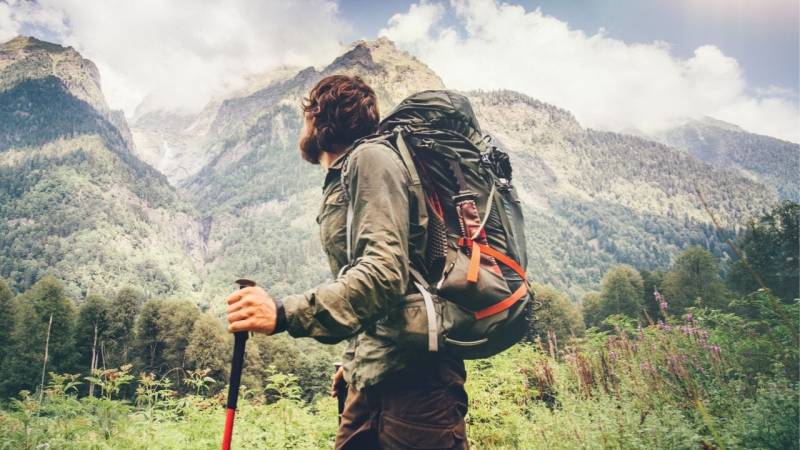
Selecting Equipment with Intelligence
Now it gets specific! Your equipment is the heart of your bushcraft experience. Every piece counts, every item has its place - and its weight.
Necessity versus Option: Pack Wisely
Here we divide the equipment into two camps:
- Essentials: That which you cannot live without.
- Knife
- Firestarter
- Shelter
- Optional: That which is nice to have, but could stay at home.
- Extra camera
- Multiple pairs of shoes
- Books
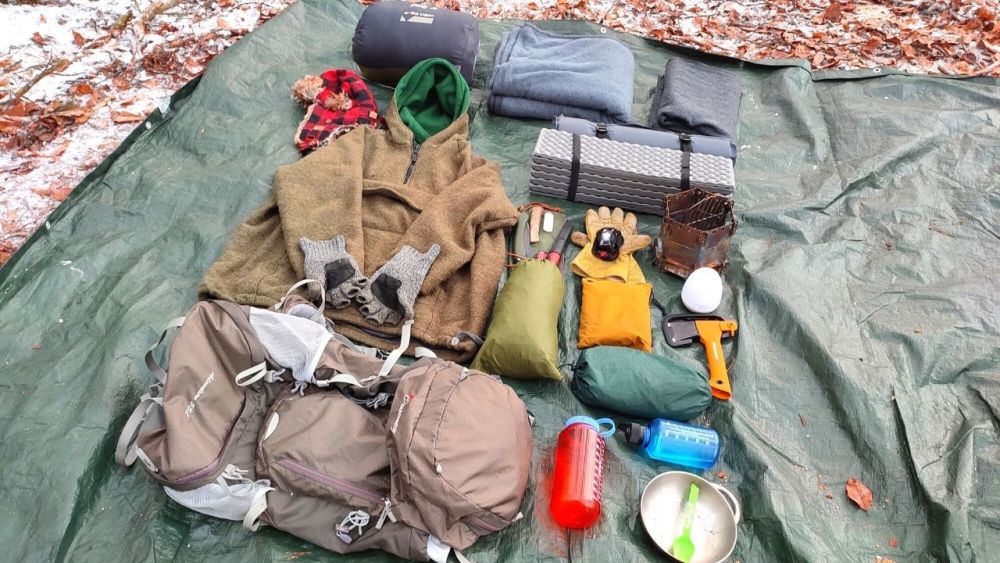
Ways to reduce weight: The lightweight alternatives
How to lighten your luggage without sacrificing essentials? Here are some tips:
- Hybrid Materials: Modern wonders that are lightweight and robust.
- What is it? Modern materials that are both lightweight and robust.
- Advantages: They are resistant to wear and tear while being lightweight.
- Examples: Backpacks made of Dyneema or Cuben Fiber, clothing made of Merino wool blends.
- Minimalist Design: Dual functions save space and weight.
- What is it? Equipment with dual functions.
- Advantages: Saves space and weight by requiring fewer individual parts.
- Examples: A shovel that also serves as a tent pole, or a sleeping bag that can transform into a jacket.
- Refillable Items: Water bottles instead of containers.
- What is it? Items that you can refill on the go instead of carrying them full.
- Advantages: Reduces the initial weight of your backpack.
- Examples: Collapsible water bottles or water filters to drink from natural sources on the go instead of carrying heavy water bottles.
Multifunctional Tools: The All-Rounders in Your Bag
Roll up your sleeves - here come the multitaskers that should not be missing in your backpack. They are true shape-shifters and real weight savers.
"Don't pack it if you don't use it twice - efficiency is the key."
Versatile and reliable: Your equipment arsenal with versatility
Whether you're starting a fire, building a roof over your head, or just peeling an apple, these tools are here for you.
Here are a few examples:
- Swiss Army Knife: Knife, scissors, and more all in one.
- Paracord: Safety, clothesline, first aid - a rope for everything.
- Cookware, stove, and fuel: Food, drink, water collection - all with just one pot.
- Spork (spoon-fork combo): Saves space and weight in your kitchen equipment.
- Hammock with integrated mosquito net: Sleep well and stay bug-free.
- Lamp with power bank: Charge your devices and find your way at night.
- Foldable water containers: Lightweight when empty and indispensable when water is scarce.
- Emergency whistle with compass: Orientation and safety in one.
Each of these tools is a burden that you gladly carry on your shoulders. Because the more versatile your equipment, the easier your adventure will be.
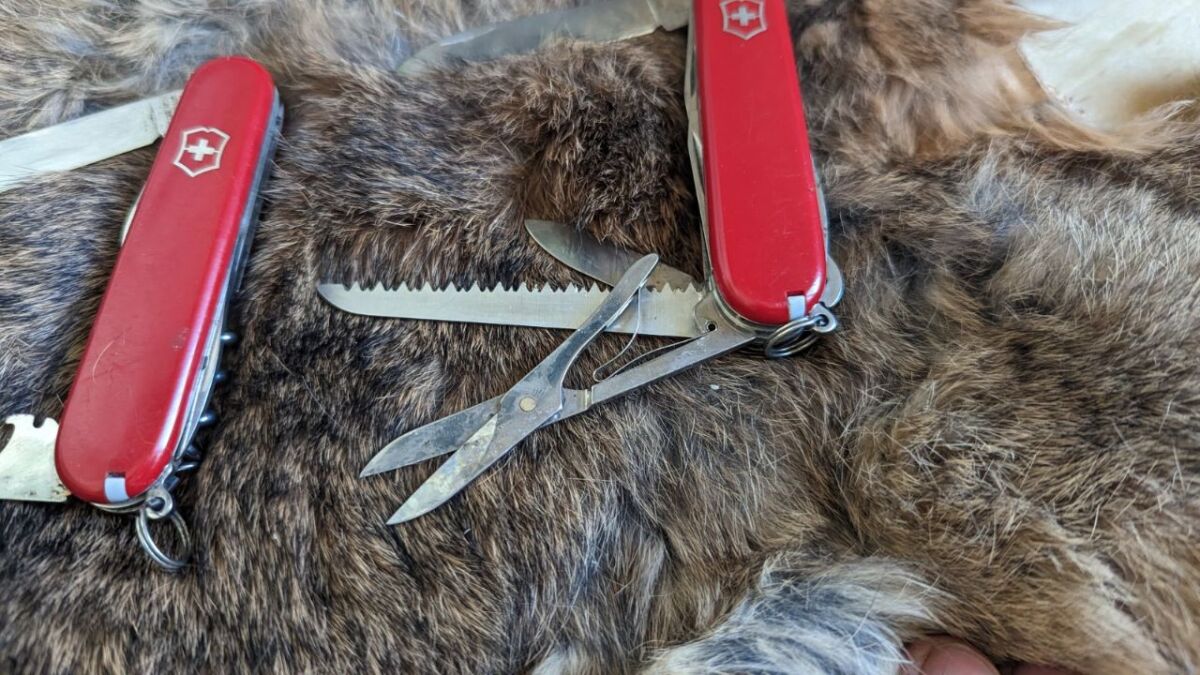
And here are my equipment recommendations from the list above:
- Lamp with power bank: the Fenix CL26R Pro, here is my review
- What is Paracord and how to use it?
- My best Swiss pocket knives + buying guide
- Review: The Swiss pocket knife Huntsman by Victorinox
Optimize without compromising
Nothing is more instructive than personal experience - try out which tools serve you the most:
- Reflect after each tour: What was useful? What just took up space?
- Befriend your tools: Get to know them, and they will become your most loyal companions.
With a keen eye for multifunctional helpers, your journey will not only be easier, but also richer in possibilities. Pack smart, live wild and free.
Water and Food: Vital Kilos for Survival
Face reality: Without water and provisions, any equipment is useless. Here we are working on the perfect balance between necessity and portability.
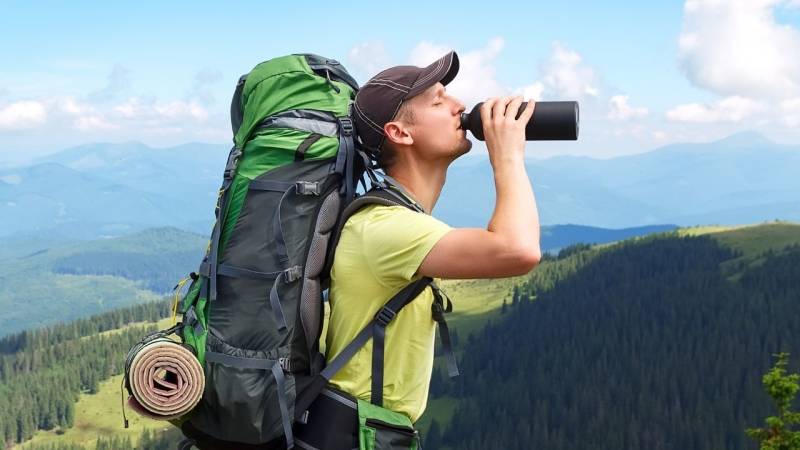
Bubbling springs and pure water
Water is life - and weight. See how you can minimize it:
- Natural water sources: Inform yourself and plan the route along rivers and lakes.
- Water purification: Small, lightweight, and essential - water filters or tablets as a backup.
Provisions with a Plan: Indulge or Survive?
Often boring, but vital: meal planning. Every detail matters:
- Calorie-rich and compact: Energetic foods such as nuts and dried meat.
- Long-lasting without refrigeration: Cans are heavy; dried food is light and nutritious.
- Do-it-yourself outdoor cooking: Learn to identify and use edible plants on site.
No worries, you don't have to starve to travel light. But you should plan and choose wisely.
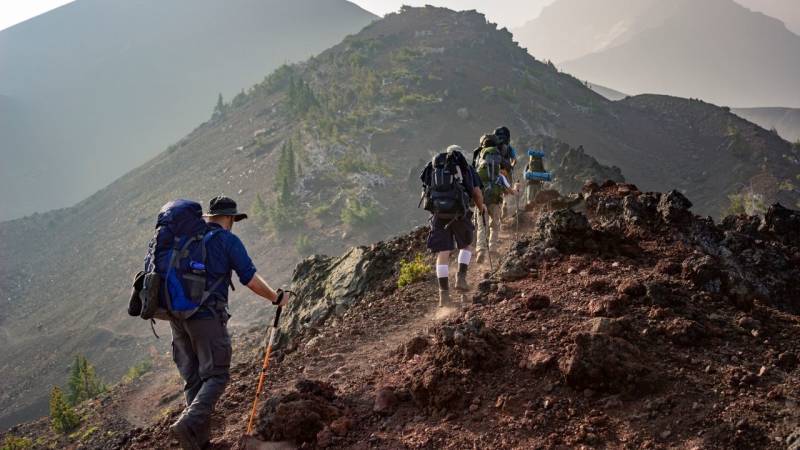
Clothing and Protection: Ready for any weather
Get dressed for the adventure - but smart. When it comes to clothing, every piece is a puzzle piece of the big picture: your protection against the elements.
Onion Skin Strategy: Layer by Layer to the Goal
Here's the trick: layers. Not too much, not too little, just right:
- Base layer: Directly on the skin, for moisture transport.
- Insulating layer: Keeps the warmth in when it gets cool.
- Protective layer: Wind and waterproof because you never know when the weather will change.
Read also
The Ultimate Guide: What Clothing to Wear for Survival Training and Bushcrafting? - The right clothing can make the difference between life and death in survival situations. In this guide, we discuss what you should wear outdoors.
Camp Sweet Camp: Tent, Sleeping Bag, and Sleeping Pad
Your second home - make it as comfortable as the weight allows:
- Lightweight Tent: Protect yourself without carrying a brick.
- Down Sleeping Bag: Warm, cozy, and compressible.
- Inflatable Sleeping Pad: A touch of luxury, feather-light.
Every gram you save on clothing and sleep setup, you can put into the joy of your adventure. Pack smart, my friend, and the journey won't be a burden.
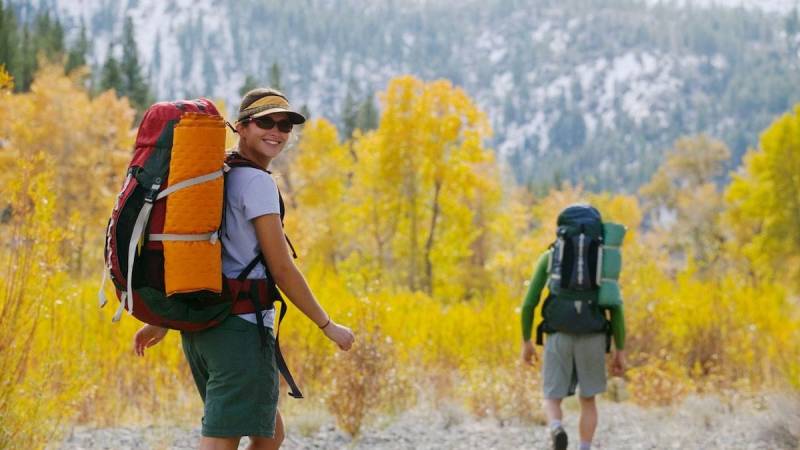
Tools and Accessories: The Helpers in Your Hand
Now it's getting sharp, literally. Your tools are your faithful servants in the wilderness. Here you decide what is vital for survival and what is luxury.
But beware: an axe can weigh more than a kilo. A survival knife (here's my top list) can weigh up to 400 grams.
Knives, Axes, and Saws: The Edge of Your Adventure
These three amigos are the backbone of your equipment. They should be in your luggage depending on the situation, duration, and region:
- Durable Knife: For carving, cutting, splitting/Batoning, cooking - a versatile lifesaver.
- Lightweight Axe/Hatchet: For firewood and other tough tasks.
- Compact Saw: Takes up little space and won't let you down.
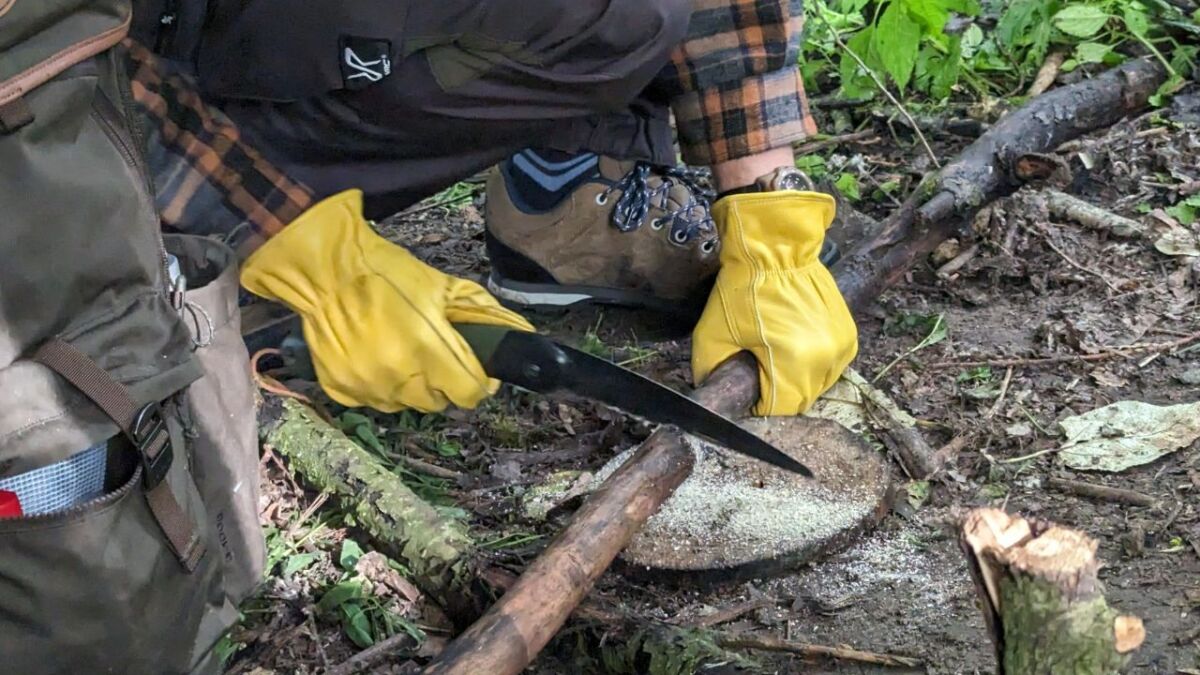
Fire and Flame: Cooking and Heating
The fire keeps you warm and cooks your food. That should be translated as:
- Firestarter: Reliable, even when it's wet and cold.
- Cooking utensils: Efficient and lightweight; making meals a celebration.
Keep the focus on quality and versatility. It pays off.
Weight vs. Benefit: The Eternal Duel
The fact is: Every additional part means more weight. Here's how you master the balancing act:
- Take only what you really use: Forget "maybe", go for "certainly".
- Tools with multiple functions: Save space and weight.
First, pack your essential tools, then think twice - do you really need more?
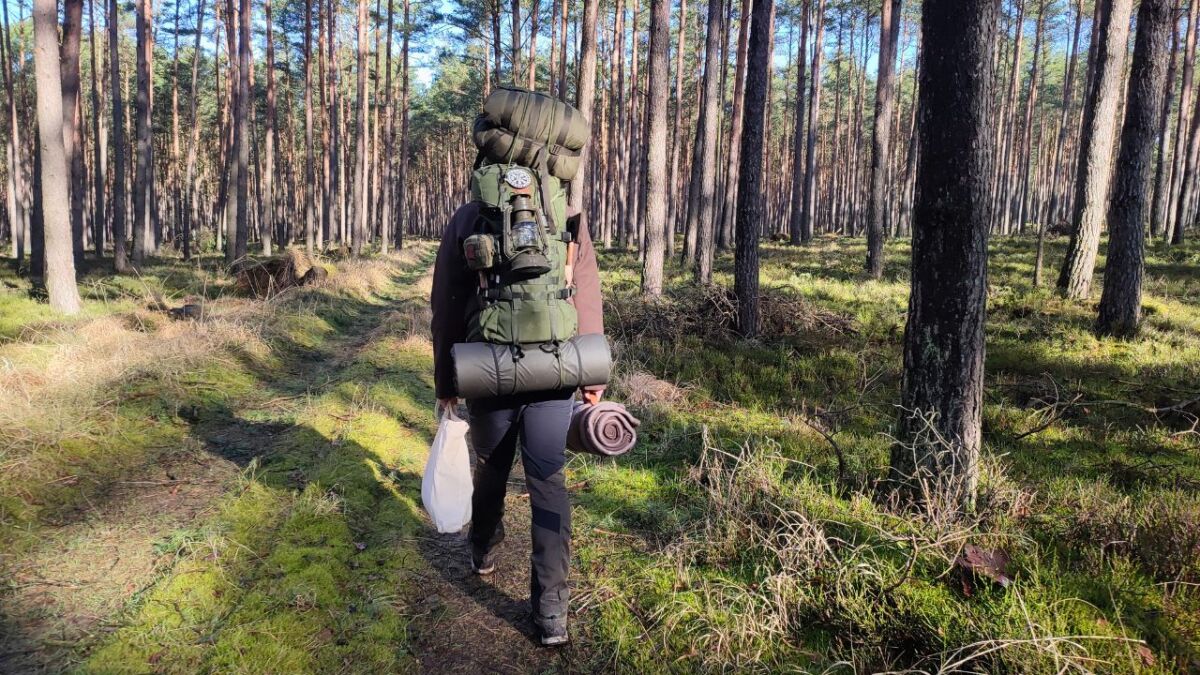
Healthy and lively: First aid and personal belongings
You don't just hike with your backpack, but also with your body - and it requires some care too. To fully enjoy the wilderness and return safely, these items are essential.
Medications and First Aid Kit: Be prepared
It's not the sexiest topic, but incredibly important:
- Personal Medications: Your health comes first.
- First Aid Kit: Compact, yet complete; prepared for any situation.
Read also
Outdoor Adventure: The Most Important First Aid Tips Every Camper Should Know - Are you ready for your next camping trip? This guide will take you through all the important first aid measures while camping and in the wilderness.
Cleanliness and Hygiene: A Piece of Civilization in the Wilderness
Even far away from civilization, the rule still applies: Stay clean, stay healthy. And that, without packing an entire bathroom:
- Biodegradable soap: Good for you and the environment.
- Microfiber towel: Lightweight and quick-drying.
- Wet wipes: For quick refreshment on the go.
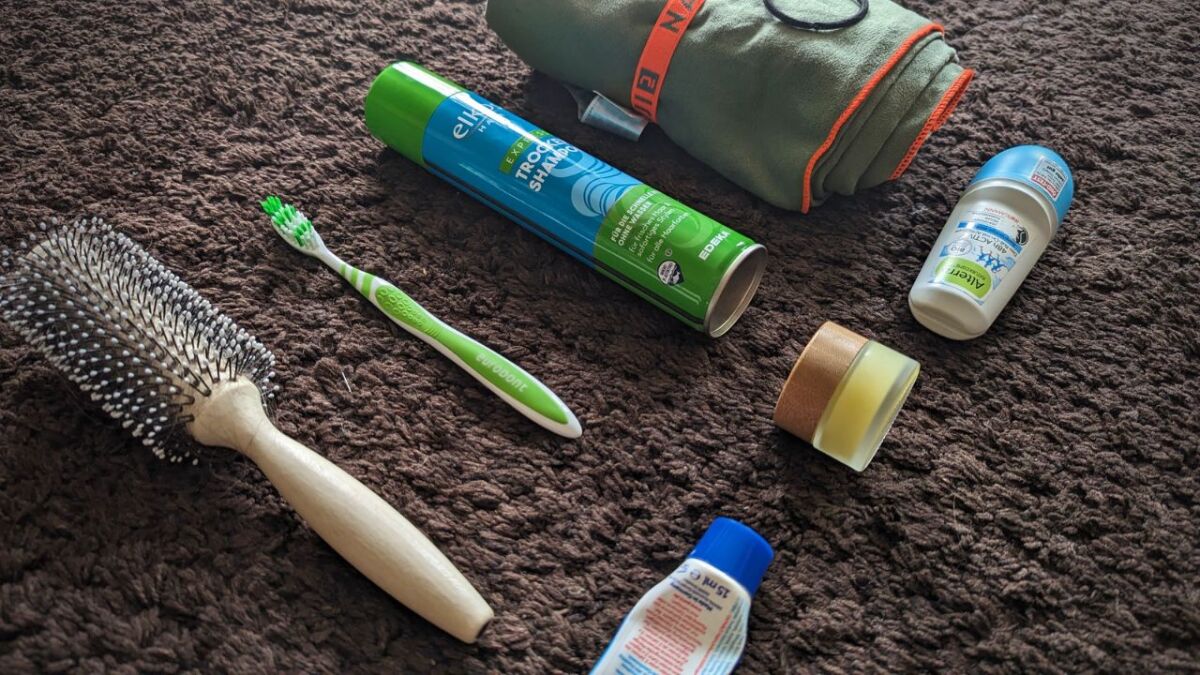
Weighing and Deciding: The Balance Game
The question is not only what you need, but also how much of it:
- Only the essential medications: Not the entire medicine cabinet.
- An efficient first aid kit: Not every bandage individually packaged.
By choosing and packing these personal and medical essentials intelligently, you protect your health and keep your backpack weight in check.
"A good preparation is half the battle - Know your route and the conditions."
Each of these items not only ensures your well-being, but also your safety. But be careful: It doesn't have to be a 200 gram piece of soap. Cut off a piece at home and take it with you.
The map knows the way: Adjustments according to the environment
The secret of a perfectly packed bushcraft backpack lies in its adaptation to the environment. Your tour through the dunes of the desert looks different from the exploration through cool mountain forests. Let's dive in and adapt.
Understanding Different Environments
Every terrain has its peculiarities:
- Mountain landscape: Breathtaking and challenging at the same time.
- Bring warm clothing for the cold nights.
- Extra pair of socks for wet feet.
- Forests: Green as far as the eye can see.
- Insect repellent in spring/summer/autumn to ward off the little pests.
- Desert areas: The heat shimmers, the sand takes its toll.
- Sunscreen and headgear are a must.
- Extra water reserves, even if they are heavy.

Adjustments for special conditions
Consider what additional challenges your environment presents and what equipment is necessary:
- Elevation: Oxygen becomes scarce.
- Climatic extremes: Heat, cold, humidity.
- Terrain: Flat or steep, open or densely vegetated.
Each of these conditions requires special equipment. The weight adjusts to the necessities - always with a focus on safety and well-being.
Remember: Your backpack is your survival kit. Pack it according to your instincts and knowledge.
Read also
Bushcraft without frustration: These 12 mistakes you should avoid as a beginner – You are starting with bushcraft and want to avoid typical beginner mistakes? Here you will learn what pitfalls there are and how to avoid them.
Carrying Techniques and Comfort: Carrying with Ease
The right way to pack is essential, but wearing it correctly is an art.
Here I will show you how you can truly enjoy your bushcraft adventure without your backpack becoming a burden.
Packing Right: Everything in its Place
A well-packed backpack makes all the difference. Here's my recommendation:
- Very heavy towards the back: The backpack's center of gravity should be close to the body's center of gravity.
- Moderately heavy downwards and outwards: Pack the moderately heavy items all the way down in the backpack.
- Light items upwards: Light objects go on top. This relieves your shoulders.
- Keep the most important things within reach: Pack things you often need on the sides or in the lid compartments.
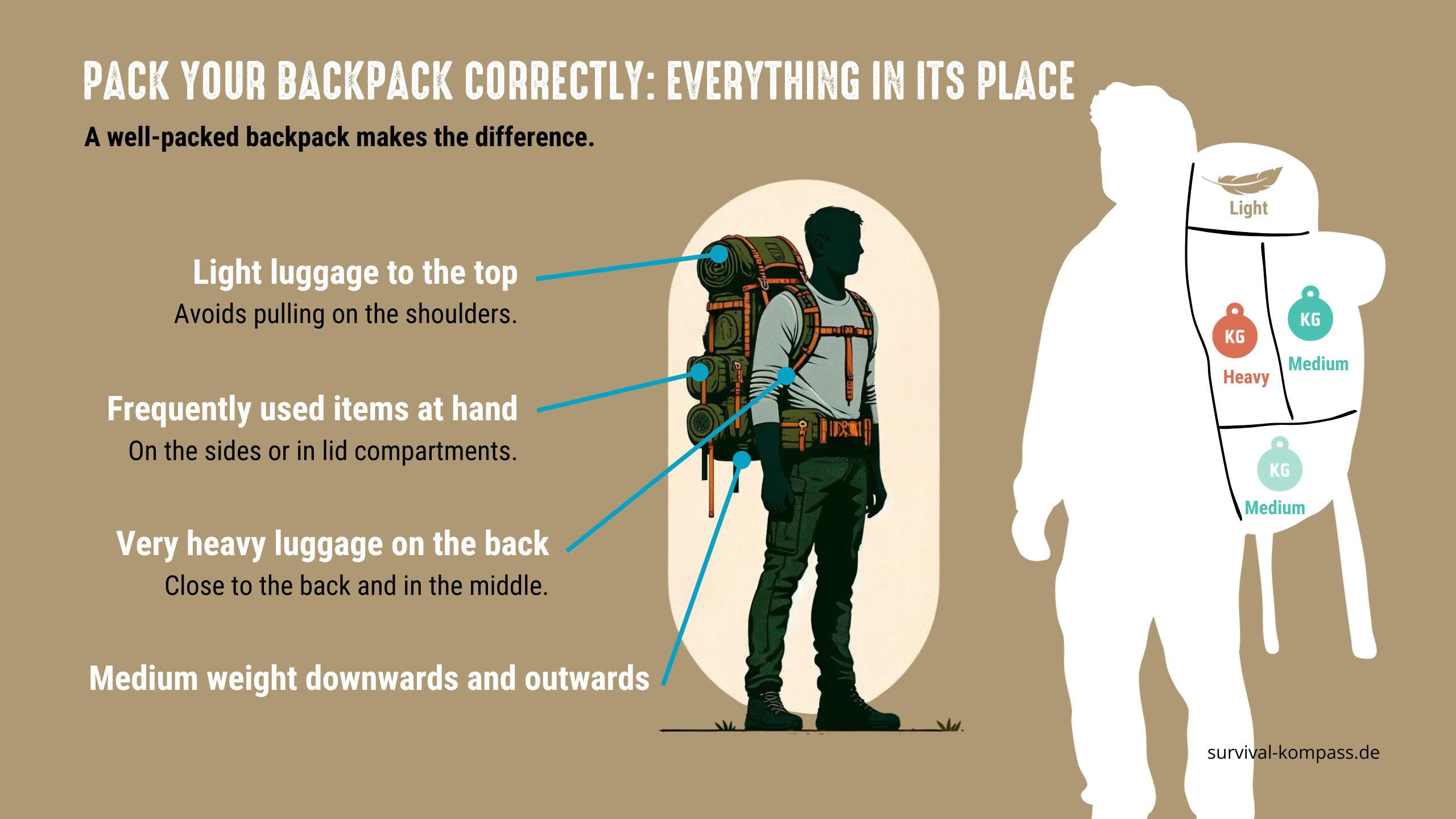
And an essential tip: Make sure not to set the center of gravity too low. A backpack packed too low will pull backwards and move away from your body's center of gravity.
When carrying heavy loads, walking becomes torture as you constantly have to fight against the weight. The shoulder straps then put excessive strain on your shoulders. Especially in difficult terrain, this can become a safety risk.
Read also
Backpack packing correctly - Your complete guide to optimal weight distribution – Learn how to pack your backpack correctly to achieve optimal weight distribution. Follow these tips for a more pleasant hike.
Balance is everything: The weighted dance
Remember: Your backpack is like a dance partner. Led incorrectly, you stumble. Well-balanced, you glide over rocks and stones.
Here are my tips for comfortable carrying with a packed backpack:
- 80% on the hips: Your legs should bear the main load, not your back.
- 20% on the shoulders: Just to stabilize the backpack, nothing more.
- Zero on the neck: There should be no pulling or pressing here.
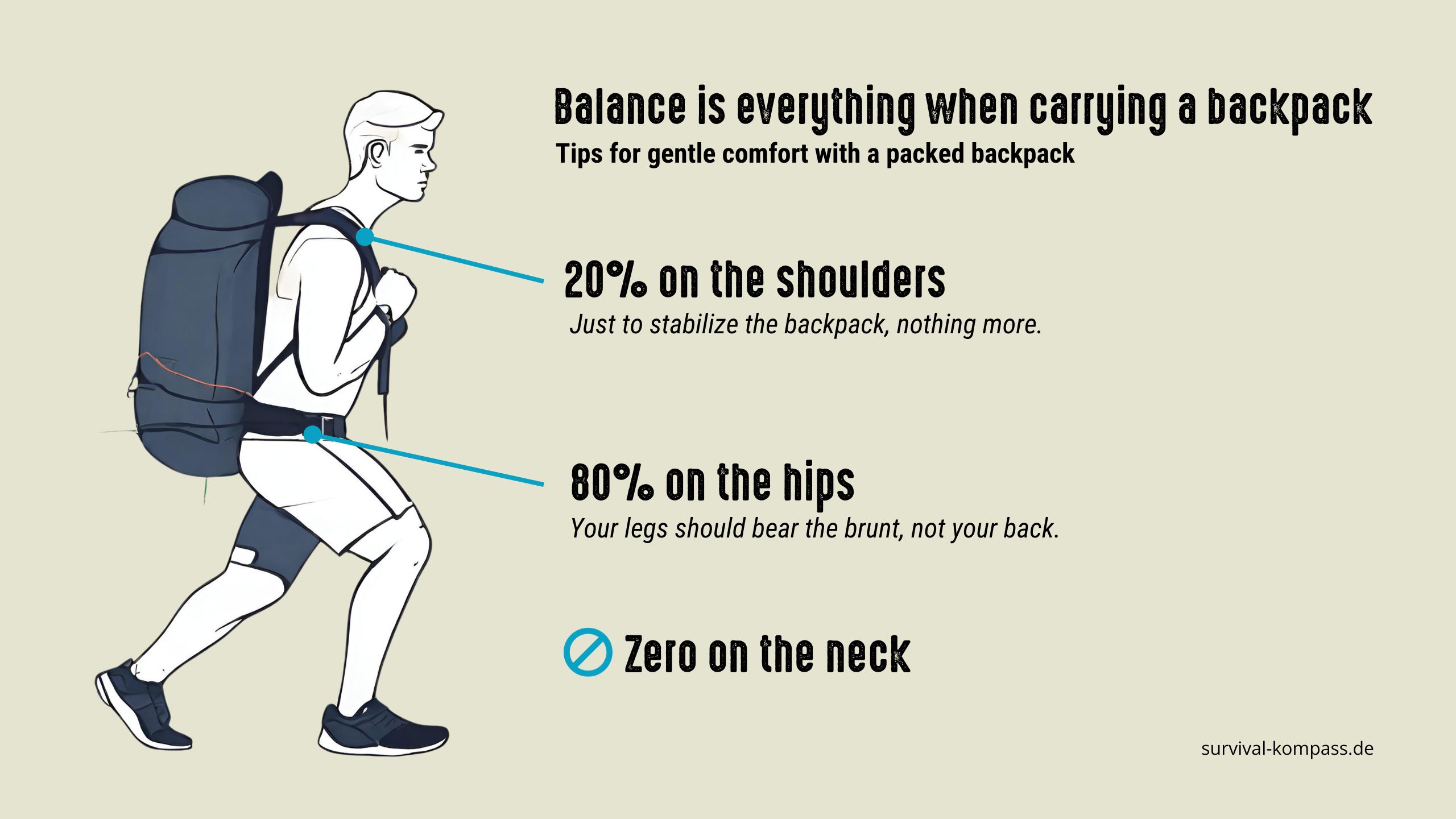
Imagine the backpack like a tailored suit. It should have the following characteristics:
- Customizable: Every backpack should be customizable to fit your body shape.
- Breathable: Against sweat (on the back) and for comfort.
- Freedom of movement: Nothing pinches, nothing clamps.
Remember: A good backpack is one that you almost forget when carrying it. This way, the weight becomes part of your body, and you can fully concentrate on the experience around you.
Final Checklist: Packing without Panic
Almost there! Before you embark on your journey, let's go through the perfect packing ritual together.
This checklist is designed to help you not forget anything important and keep the weight under control.
Summary and final tips
Remember:
- Light luggage = Easy way.
- The necessary takes precedence over the pleasant.
- Adaptability is the key to wisdom in the forest.
Before sealing: The final check
And now, the final look:
- Check weight again: Too heavy? Consider what you can leave at home.
- Pack smart: Put heavy items at the bottom, distribute light items.
- Accessibility: Place granola bars on the side, rain gear on top.
With this, you are prepared for the adventure, my friend. Your packed bushcraft backpack will be your portable fortress - ready to serve you and protect you wherever the journey takes you.
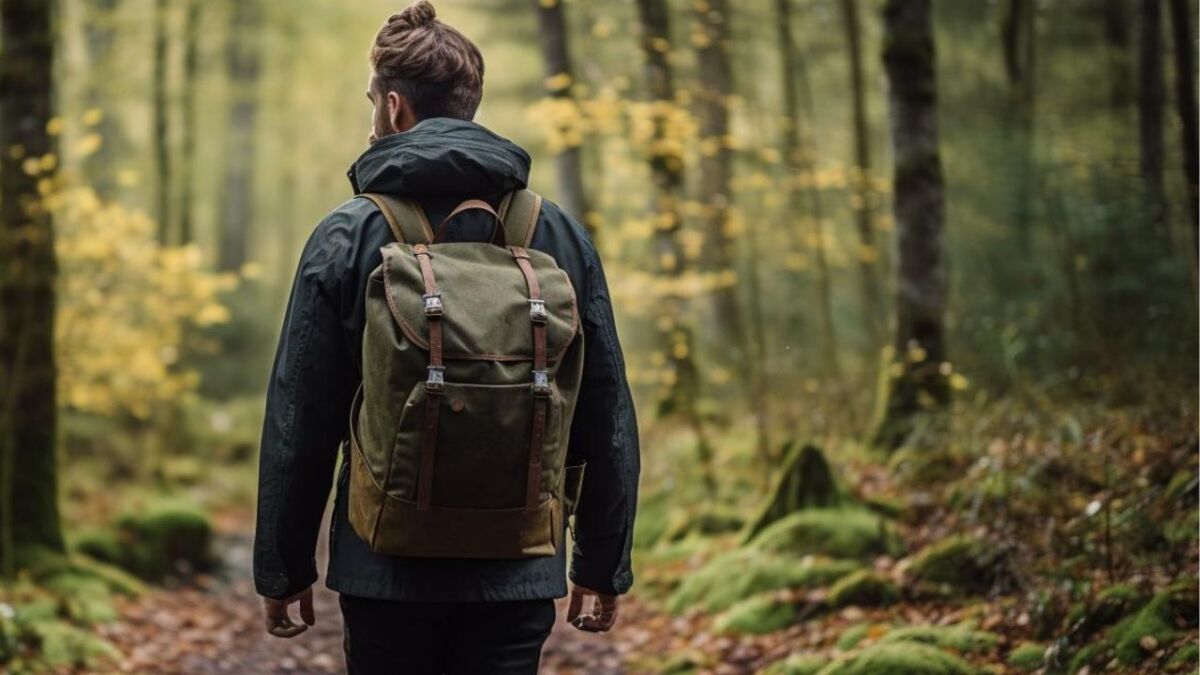
Conclusion: Your Bushcraft Backpack, Your Adventure
The journey through the world of the perfect backpack weight is coming to an end. Do you feel better equipped?
The goal was for you to realize: There is no one-size-fits-all answer, but a personal formula for every bushcraft adventure.
Conclusions for your backpack weight
Reflect briefly:
- Every Bushcrafter carries their world on their back. Your weight is unique.
- A backpack that is too heavy is a spoilsport, confidence is light.
- Nature offers more than you think. Use it wisely.
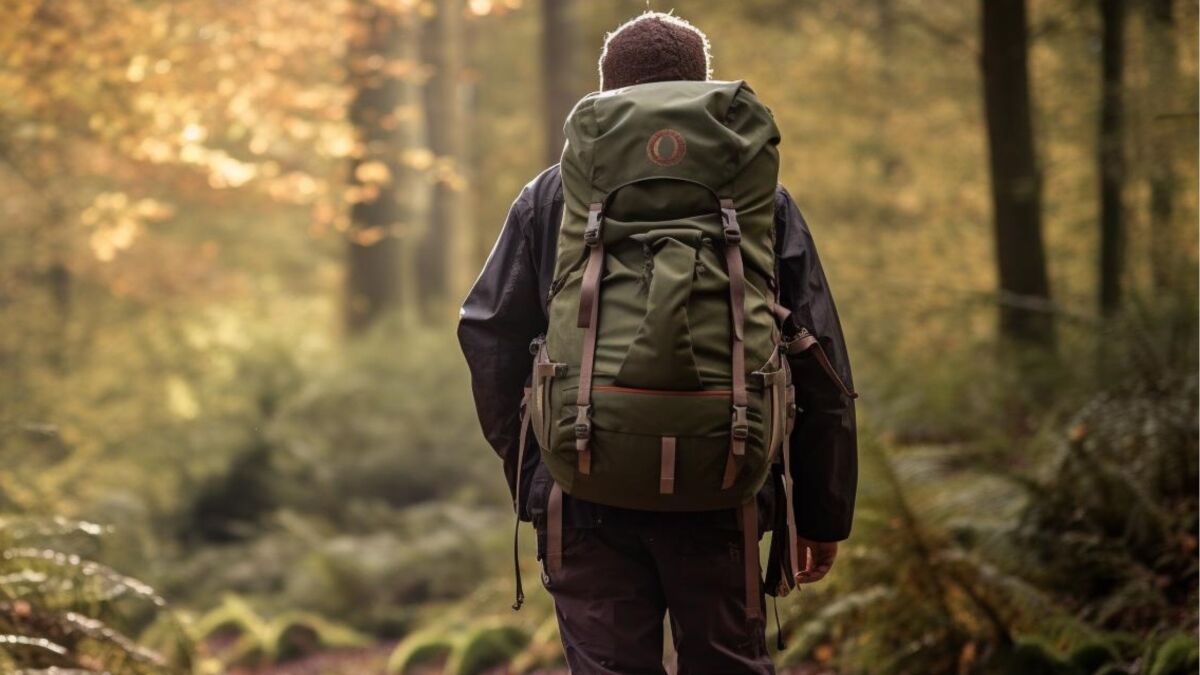
Recommendations for Departure
Now that your packing list is complete, and the weight is correct, a few final words:
- Practice makes perfect: Go out, try it out, and learn.
- Always know what you're wearing: And why.
- Enjoy every step: Your backpack is not just a burden, but also a treasure chest.
With this wisdom, you are ready to close the door behind you, shoulder your backpack, and plunge into your legend. Go with ease and curiosity, my adventurer!
How much does your packed backpack weigh?
Dare to tell me in the comments. Let's exchange.


Author of the guide
Martin Gebhardt
Hey, I'm Martin. On my blog, you will learn the basics and numerous details about living in the wild. I think survival, bushcraft and the good life in nature are the keys to happiness. Find me here on Instagram or on YouTube. You can find more about my mission on the About Me page.
Was this guide helpful?
41 people found this guide helpful.
5.00 out of 5 points (41 Ratings)
Comments (0)
This post may contain affiliate links. So if you click on the links and make a purchase, I will receive a small commission at no additional cost to you. Click here, to learn more about it.


